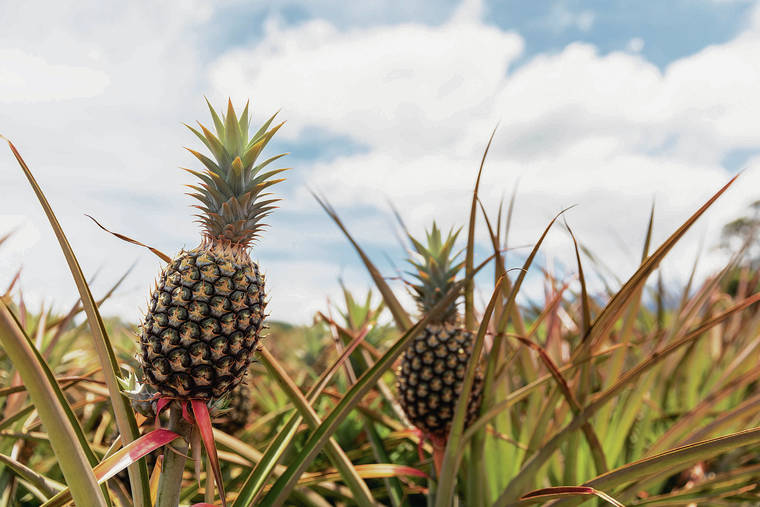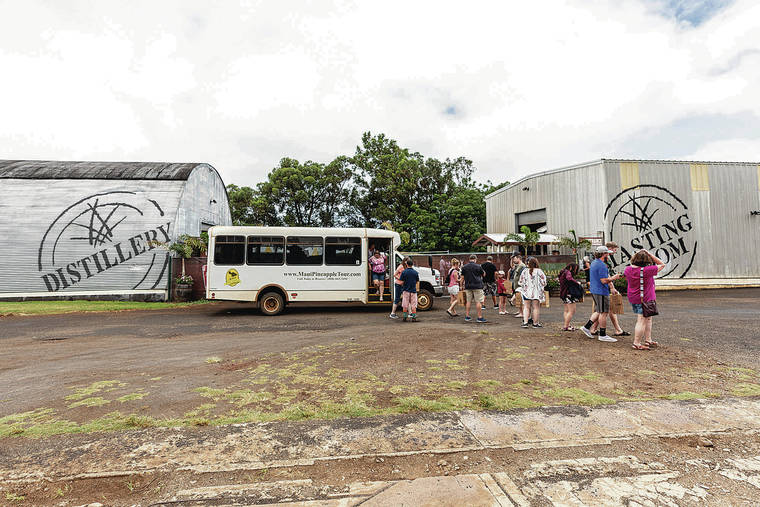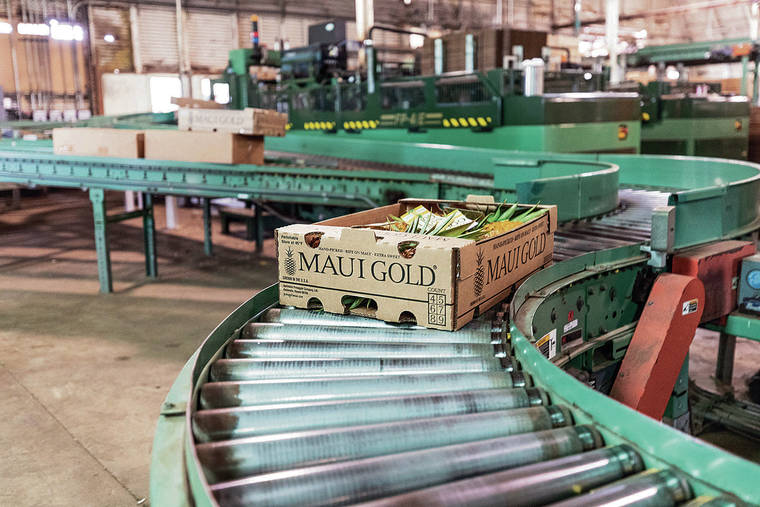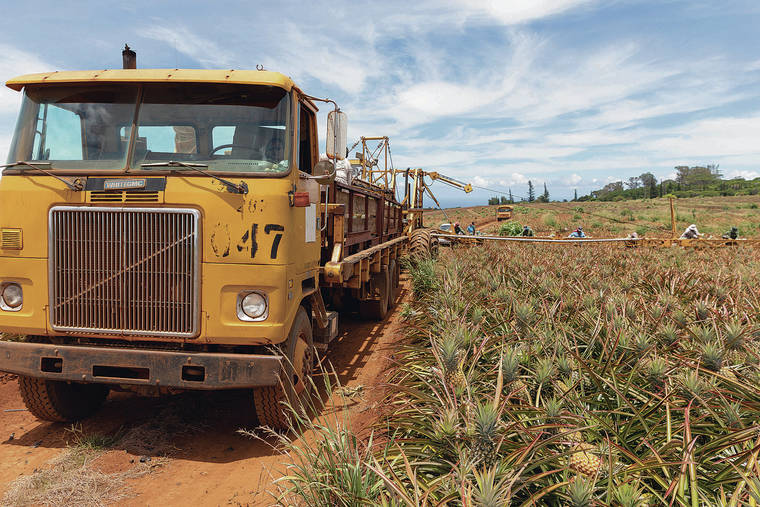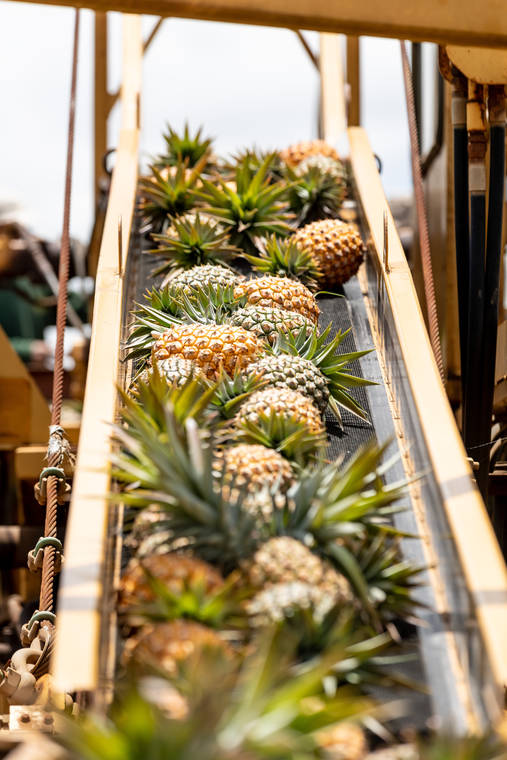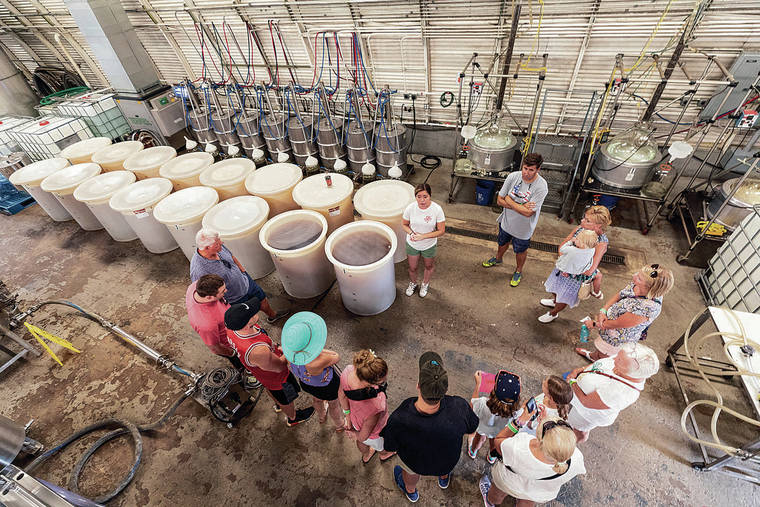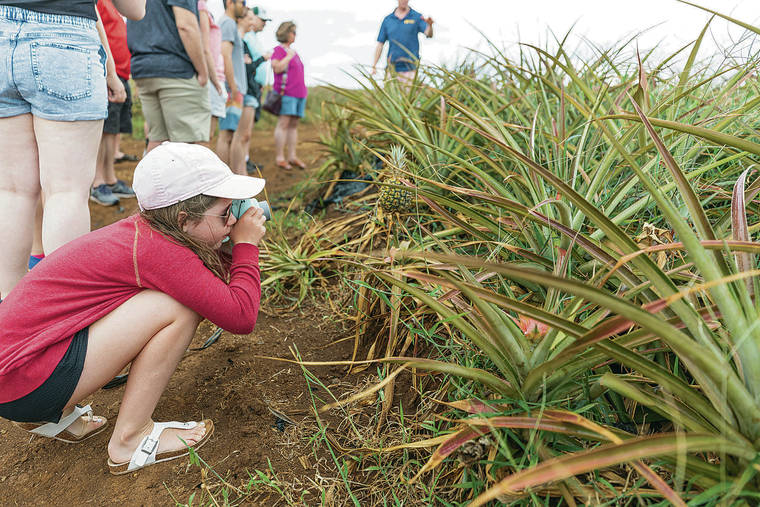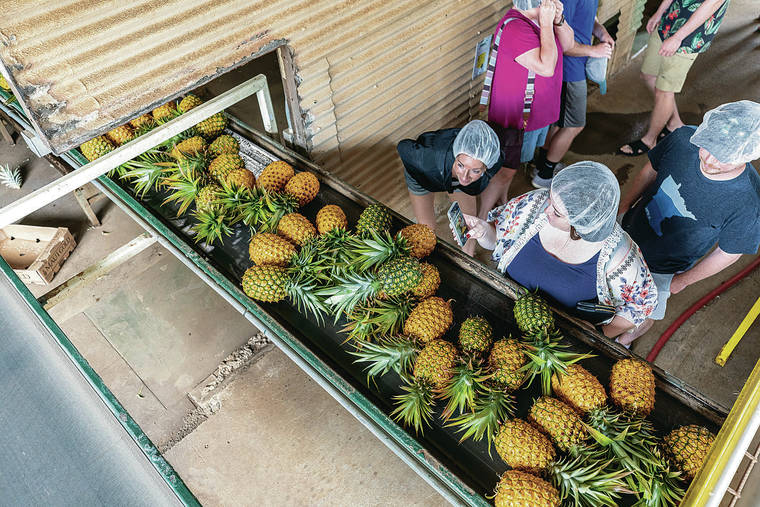HALIIMAILE, MAUI >> It’s easy to see Hawaii’s connection to pineapple farming at Maui’s main airport, where plush toys, picture frames, candy and other items made in the oblong fruit’s image are for sale along with three-packs of the real thing for $29.95. At the Maui Pineapple Store in Lahaina, there’s also pineapple hot sauce and pineapple spice soap.
What’s less apparent, though, is how the local pineapple industry sidestepped a shutdown trend over the last four decades to outlast sugar cane, the longtime king crop of Hawaii agriculture.
Three years after the last sugar plantation in the state disappeared, two major pineapple farms stemming from the bygone plantation era are still running.
One, in Haliimaile, defied a shutdown twice in the last decade and has been supported for the last 18 months by a company making vodka, gin and other spirits from pineapple juice.
The other, on Oahu, is still run by what used to be one of Hawaii’s four dominant pineapple plantation operators, though on a smaller scale.
These two companies, Maui Gold Pineapple Co. and Dole Food Co., generally supply 100% of the statewide market for fresh pineapple, which also includes contributions from much smaller local farms.
“If Dole does well, we do well. If we do well, Dole does well,” said Rodrigo “Rudy” Balala, Maui Gold general manager.
Of the two companies, Maui Gold has had the more unsettling ride — so much so that many people on Maui were unaware recently that the company was still around, according to farm manager Kary Hisashima.
“People just figured we went out of business,” he said.
A lot of Hawaii pineapple producers did meet that fate, largely since the 1960s under pressure from lower-cost plantations in Asia and Central America often run by the same companies that dominated pineapple farming in Hawaii.
Commercial pineapple farming in Hawaii dates back to the late 1880s and initially produced fruit for canning. Production peaked in 1955 with 1.5 million tons of fruit grown on 76,700 acres mainly on Oahu, Maui, Molokai and Lanai, according to the state Department of Agriculture.
In the early 1960s, Hawaii pineapple growers supplied more than 80% of the world market for canned pineapple. But a decline took hold by 1966, and a later shift to growing sweeter and less acidic varieties for fresh fruit sales didn’t stop most of the demise.
Kauai lost its last plantation, the 2,200-acre Hawaiian Fruit Packers farm, in 1973.
On Molokai, Dole pulled the plug in 1975 on a 12,500-acre farm it acquired five years earlier from Libby McNeill & Libby, while Del Monte’s last harvest on a portion of what had been a 6,000-acre farm there was in 1988.
Lanai, long nicknamed the Pineapple Isle, was once the world’s largest pineapple plantation at roughly 15,000 acres. But that Dole operation ceased in 1992.
Oahu and Maui outlasted other islands for pineapple production, but the industry has come close to extinction on these islands as well.
In 2006 Del Monte Fresh Produce quit the business on Oahu. That left just two major pineapple growers in Hawaii: Dole on Oahu and Maui Pineapple Co.
Dole’s Oahu pineapple plantation once covered 12,500 acres in Wahiawa, but by the mid-1970s was down to 4,500 acres as the company shifted from canning to fresh fruit sales.
After further shrinking its operation to 2,700 acres around 2006, California-based Dole is back up to 4,100 acres on Oahu, where it produces pineapple mainly for the local market but also Western states.
Dole spokesman Bill Goldfield said the farm maintains some profitability but also helps support the Dole Plantation visitor attraction in Wahiawa and holds tremendous value as an “iconic product in Hawaii that so much of the company’s image is founded upon.”
Gold rush saves planters
On Maui, sustaining that iconic product has teetered on the brink twice.
Maui Pineapple Co., a subsidiary of Maui Land & Pineapple Co., stayed in business for 100 years in part by branching into resort and other urban development on much of what had been 12,000 acres of pineapple fields largely around Kapalua in West Maui. In 2009 the company announced plans to shut down its last roughly 3,000 acres of pineapple operations in Haliimaile on the lower slopes of Haleakala, after closing its Kahului cannery in 2007.
That decision stood to wipe out pineapple’s heritage on another island. The move also hurt suppliers and vendors, including M. Yamamura & Sons, a nearly 600-acre pineapple farm in Haiku which was started by Hisashima’s grandfather and sold its crop to Maui Pine.
However, a handful of company veterans including Balala and former Maui Pine President Doug Schenk preserved much of the operation by forming Haliimaile Pineapple Co., doing business as Maui Gold Pineapple.
Maui Gold, financed by Ulupalakua Ranch owner Pardee Erdman, leased about 1,000 acres and purchased equipment from Maui Pine to continue pineapple farming that preserved 66 of the farm’s 206 jobs.
Balala, who was Maui Pine’s director of fresh and harvesting operations, recalled that banks declined to finance what he jokes was a “dumb” idea to attempt to salvage a farm that was losing money amid a recession.
“We were underfunded going into it, but we had to take that chance to keep it going,” he said.
Maui Gold inherited some pineapple in the fields to start with and aimed to plant 120 to 150 acres a year. Each acre can support about 30,000 plants, which are harvested three times over three years before replanting after a field rests for a year. New plants take about 18 months to produce fruit.
Planters including 63-year-old Arnold Ancheta, a veteran with 27 years of experience going back to Maui Pine, work two days a week and can plant 9,000 stalks a day.
“It’s good,” Ancheta said of the work that pays $30 a hour plus a bonus after the first 6,000 stalks.
In good spirits
After about five years Maui Gold had expanded to about 480 acres planted and developed a good revenue stream with sales of fresh whole fruit, fresh cut fruit and juice. Fresh fruit customers included Maui grocery stores, Costco, other retailers, consumers online and even one grocer in Oregon.
Juice buyers include Maui Brewing Co., MauiWine, Ola Brew Co. on Hawaii island and Haliimaile Distilling Co.
Other income streams included farm tours and supplying companies making value-added products including syrups and jams.
But then in 2015 the farm got hit with extremely heavy rain that damaged the crop and created a dire situation. Hisashima said lost sales constricted revenue needed to pay for planting, fertilizer and other things, which reduced production and quality. That, in turn, further hurt sales and led to the company’s biggest customer, Costco, dropping Maui Gold.
In essence, a slow death spiral was cutting Maui Gold to the core.
With the farm on the brink of another shutdown, Maui Gold sought financial help from the owner of the business making spirits from Maui Gold pineapple juice next door in a former Maui Pine truck maintenance building.
California-based LeVecke Corp., a 70-year-old bottler of spirits which created PAU Maui Vodka in 2006, followed by Haliimaile Distilling in 2010, bought Maui Gold in March 2018.
Joe LeVecke, president of the family firm started by his great-grandfather, said the acquisition made good business sense but also had a bigger emotional and cultural legacy benefit by continuing something sustained by generations of Hawaii residents, including kids picking pineapples during the summer.
“It’s a responsibility,” he said. “We’re stewards of pineapple on the island for this moment in time.”
Over the past 18 months, Maui Gold reinvested in planting, improved farm practices that now include using biodegradable mulch film, regained Costco as a customer, reduced its lease to 800 acres and downsized its workforce to 52 through efficiencies.
LeVecke said Maui Gold this year will be profitable, and he is looking ahead at expansion if the company can obtain a long-term lease for perhaps 1,300 to 1,500 acres.
“The future can be really, really bright,” he said. “We’d love to grow the farm.”
Balala, who is 56 and worked in only one industry for the past 41 years, is appreciative of LeVecke’s help.
“It’s a great marriage,” Balala said. “We got to make sure that this thing continues. It’s an integral part of Hawaii’s agriculture community. You don’t want to see something that’s been growing in Hawaii for so long finally disappear.”
History of Hawaii’s pineapple industry
1813: Don Francisco de Paula y Marin, Spanish adviser to King Kamehameha I, introduces pineapple, or hala kahiki, to Hawaii.
1885: English horticulturalist Capt. John Kidwell, recognized as the pioneer of Hawaii’s pineapple industry, pursues crop development trials in Manoa.
1890: Kidwell plants Smooth Cayenne variety, ideal for canning, near Pearl Harbor.
1900: “California homesteader” Alfred W. Eames starts selling fresh pineapple at what would become California Packing Corp. and Del Monte Fresh Produce (Hawaii) Inc.
1901: Businessman and future “Pineapple King” James Drummond Dole incorporates Hawaiian Pineapple Co. and begins growing fruit on 60 acres in Wahiawa.
1903: Maui’s missionary Baldwin family establishes a firm that becomes Maui Pineapple Co.
1913: Henry Ginaca creates machine to peel and core pineapples for Dole.
1922: Dole buys nearly all of Lanai to establish the world’s largest pineapple plantation, covering about 15,000 acres.
1930: Eight canneries pack 9 million cases of canned pineapple.
1955: Pineapple production peaks at 76,700 acres planted and 1.5 million tons of harvested fruit. Sales total about $110 million.
Early 1960s: Hawaii pineapple growers supply more than 80% of the world’s canned pineapple.
1966: Pineapple production is firmly in decline.
1973: Last pineapple plantation on Kauai closes.
1975: Dole Food Co., successor to Hawaiian Pineapple Co., cuts size of the once 12,500-acre Wahiawa plantation to 4,500 acres from 9,000 acres.
1976: Del Monte begins national distribution of fresh Hawaii pineapples.
1983: Del Monte ceases Hawaii canning operations.
1988: Last pineapple plantation on Molokai closes.
1989: Del Monte introduces fresh-cut chilled Hawaii pineapple, the first nationally distributed, fresh-cut, refrigerated fruit item.
1992: Dole closes Iwilei cannery and tears down landmark pineapple water tower a year later.
1993: Dole ceases pineapple production on Lanai.
1997: Del Monte unveils a sweeter premium pineapple, Del Monte Gold, which goes on to compete with sweet varieties sold fresh by Maui Pine and Dole.
1998: Maui Pine announces plans to extend operations to Indonesia and Central America.
2004: Del Monte reduces Oahu pineapple farming to 4,000 acres from 6,000.
2006: Del Monte ceases all Hawaii pineapple operations. Dole’s Oahu farm shrinks to 2,700 acres.
2007: Maui Pine, Hawaii’s last pineapple canner, stops canning and shifts all production to fresh fruit.
2009: Maui Pine, which once farmed 12,000 acres, quits farming its last 3,000 acres.
2010: Haliimaile Pineapple Co. formed to continue farming some Maui Pine land.
2015: Haliimaile Pineapple falters amid cash crunch after bad weather.
2017: Dole reports increase in Oahu farm size to 4,100 acres.
2018: LeVecke Corp. buys Haliimaile Pineapple to keep it in business.
2019: LeVecke deems Haliimaile Pineapple turnaround a success and contemplates expansion.
Source: State Department of Agriculture, Honolulu Star-Advertiser research
Correction: An earlier version of this story misspelled Kary Hisashima’s last name.

